Gluten-Free Potato Salad always takes me back to summer afternoons in my grandma’s backyard—barefoot on the grass, mason jars filled with sweet tea, and a long picnic table covered with homemade dishes. But the real star? Her potato salad. Creamy, tangy, with just the right crunch. It was simple, comforting, and made with love—without any gluten in sight.
Back then, we didn’t talk about gluten-free or allergen-friendly cooking. We just cooked real food from real ingredients. But today, whether you’re Celiac, gluten-sensitive, or just watching what goes into your meals, there’s a way to enjoy that same nostalgic, full-flavored potato salad—100% gluten-free and just as satisfying.
In this article, I’ll walk you through everything you need to know about making a truly gluten-free potato salad—from understanding gluten risk to choosing the right potatoes, plus pro tips on texture, seasoning, storage, and more. Whether you’re prepping for a weekend BBQ or a weekday lunch, you’re about to make a side dish that everyone (gluten-free or not) will ask for seconds of.
Looking for inspiration? Try our gluten-free biscuits and gravy for the ultimate Southern-style combo.
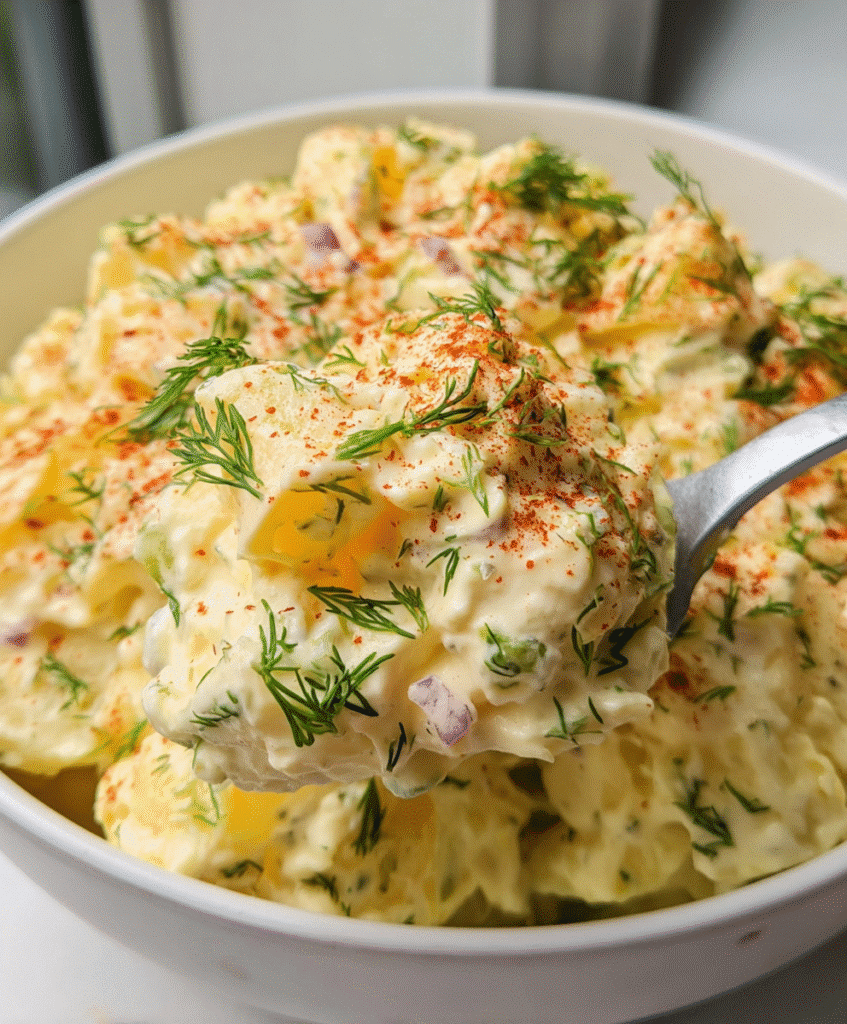
Table of Contents
Table of Contents
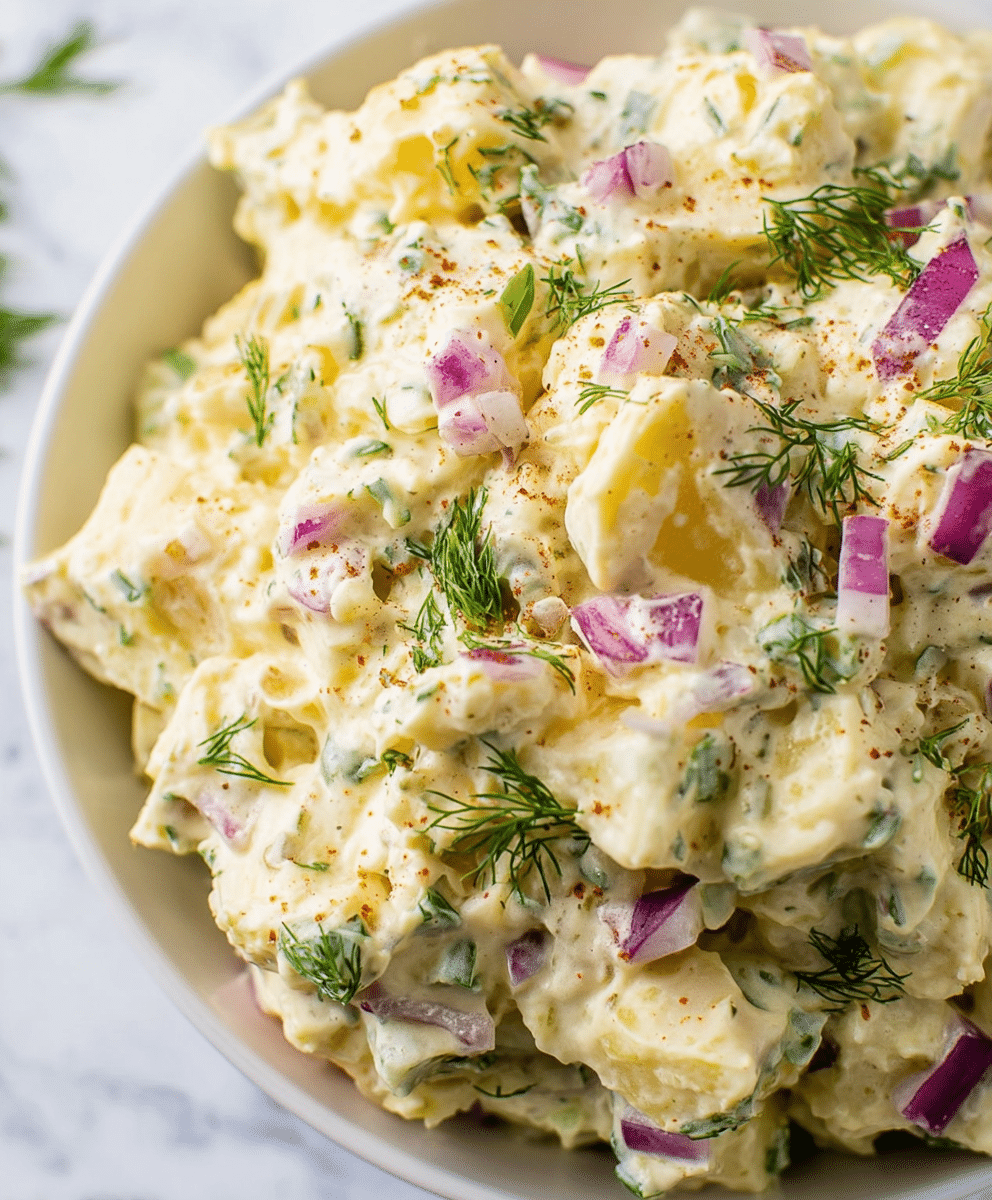
Gluten-Free Potato Salad
Ingredients
Equipment
Method
- Peel and dice potatoes into 1-inch cubes.
- Boil potatoes in salted water (1 tbsp salt) for 10–12 minutes until fork-tender. Drain and let cool.
- In a bowl, mix mayonnaise, relish, mustard, vinegar, sugar, remaining 1 tsp salt, pepper, and dill.
- Add diced celery and onion. Stir well.
- Gently fold in the potatoes and chopped eggs.
- Cover and chill in the fridge for at least 2 hours.
- Garnish with paprika and extra dill before serving.
Nutrition
Notes
- The salad needs time to chill in the fridge for the flavors to meld. Make this 2 hours to 1 day before your event for optimal freshness!
- Choose the Right Potatoes – Yukon Golds are great for their creamy texture, but if you prefer a firmer bite, red potatoes are a good alternative.
- Uniformly cut potatoes and mix-ins to ensure consistent bites.
- Add salt when boiling your potatoes. Cooking them in salted water enhances their natural flavor.
- If the salad feels dry after chilling, stir in 1–2 tablespoons of mayonnaise or a splash of vinegar to freshen it up.
- Store leftovers in an airtight container in the fridge for up to 4 days.
Tried this recipe?
Let us know how it was!What Makes a Potato Salad Gluten-Free?
Understanding Gluten and Hidden Ingredients in Potato Salad
When people think of gluten-free potato salad, they often assume it’s naturally safe—after all, potatoes, eggs, and mayo don’t scream “gluten,” right? But gluten is a sneaky guest. It hides in processed condiments, spice blends, and even in your favorite mustard or relish.
To be clear, gluten-free potato salad means every single ingredient must be free of wheat, barley, rye, or contaminated fillers. That includes:
- Mustard that isn’t thickened with wheat flour.
- Vinegars that aren’t malt-based.
- Mayonnaise without modified food starch or additives.
- Seasoning blends that contain anti-caking agents derived from gluten sources.
Even small amounts of cross-contamination can trigger reactions for those with Celiac disease or gluten sensitivity. So when preparing gluten-free potato salad, it’s essential to either make your own condiments or buy certified gluten-free versions.
| Ingredient | Gluten Risk? | Safe for Gluten-Free Potato Salad? |
|---|---|---|
| Apple Cider Vinegar | Low | Yes |
| Malt Vinegar | High | No |
| Yellow Mustard (generic) | Medium | Only if labeled gluten-free |
| Dill Relish | Low | Usually safe, check labels |
| Celery & Onion | None | Yes |
| Mayonnaise | Varies | Stick with certified GF brands |
Always read every label. If you’re unsure about a condiment, swap it for a simpler or homemade option. A homemade dressing using just gluten-free mayo, mustard, vinegar, and spices can keep your gluten-free potato salad totally safe and 100% delicious.
Essential Ingredients for a Safe Gluten-Free Potato Salad
To make sure your gluten-free potato salad is both safe and satisfying, you need to start with a list of trusted ingredients. Stick with whole foods and gluten-free-labeled pantry items to avoid any surprises.
Here’s what you’ll want:
- Yukon Gold Potatoes – These give the salad its creamy bite.
- Gluten-Free Mayonnaise – Hellmann’s and Sir Kensington’s are reliable choices.
- Yellow or Dijon Mustard – Just ensure it’s labeled gluten-free.
- Apple Cider Vinegar – More flavorful than white vinegar and safe.
- Pickle Relish – Adds sweetness and tang. Check that it’s gluten-free.
- Celery & Red Onion – Provide the perfect crunch.
- Fresh Dill – For that herby freshness that elevates every bite.
- Boiled Eggs – Classic, filling, and naturally gluten-free.
- Salt, Pepper, Paprika – Go with single-ingredient spices.
By keeping these ingredients clean and label-checked, you’re well on your way to a flavorful and gluten-free potato salad that’s perfect for backyard BBQs, potlucks, or just a cozy night in.
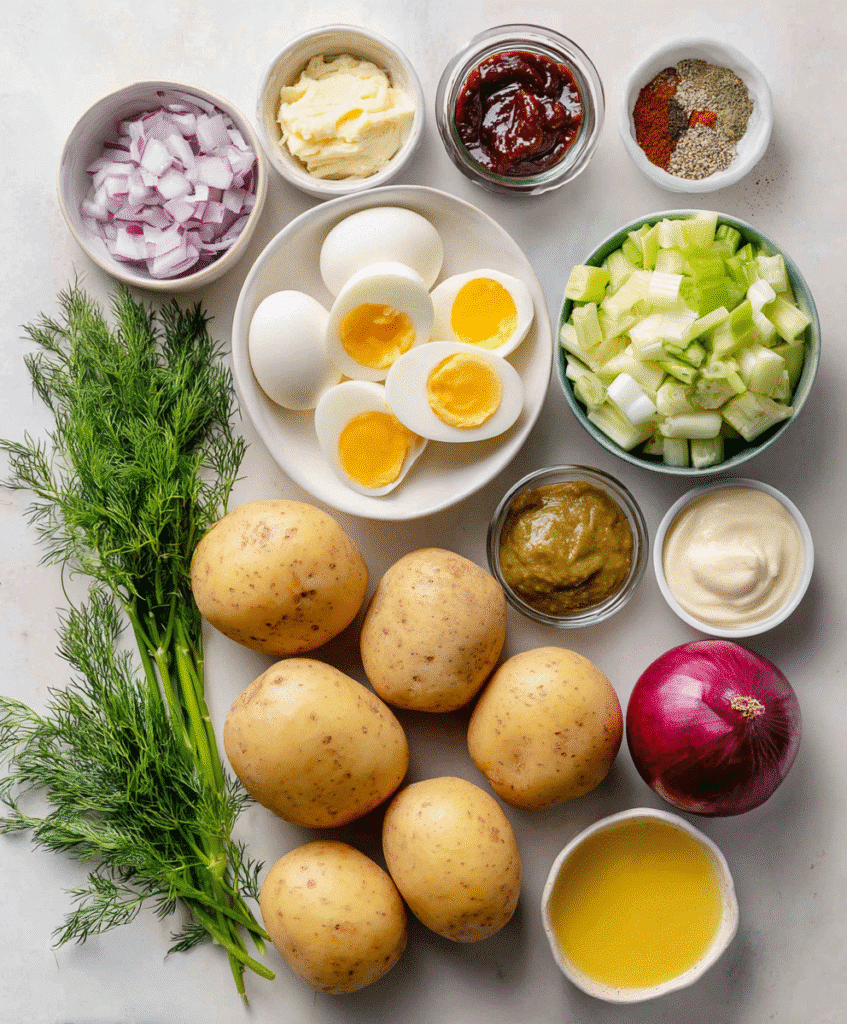
Classic Gluten-Free Potato Salad Recipe (Step-by-Step Guide)
Ingredients You’ll Need for a Traditional Southern-Style Recipe
To make a creamy, tangy, and totally satisfying gluten-free potato salad, you’ll want to gather the freshest ingredients and double-check labels on any packaged items. This classic Southern-style version is rich in flavor, simple to prepare, and ideal for cookouts or meal prep.
Here’s what you’ll need:
| Ingredient | Amount | Notes |
|---|---|---|
| Yukon Gold potatoes | 2 ½ lbs | Best for a smooth, buttery base |
| Salt | 1 tbsp + 1 tsp | For boiling and seasoning |
| Mayonnaise (gluten-free) | 1 cup | Hellmann’s or a labeled GF brand |
| Pickle relish | ½ cup | Sweet or dill, check for GF certification |
| Yellow mustard | 2 tbsp | Adds classic tang |
| Apple cider vinegar | 2 tsp | Enhances flavor and balances richness |
| Sugar | 1 tbsp | Optional, for Southern-style sweetness |
| Black pepper | ½ tsp | Adjust to taste |
| Fresh dill | 1 tbsp | Use dried if fresh isn’t available |
| Celery ribs | 2 | Diced small for crunch |
| Red onion | ¼ cup | Finely diced for sharpness |
| Boiled eggs | 4 | Chopped |
| Paprika | Sprinkle | Optional, for garnish |
This combination makes enough for 6–8 servings and hits all the right notes—creamy, tangy, and crisp.
How to Make Gluten-Free Potato Salad the Right Way
Here’s the exact method to nail the texture and flavor every time. The key? Timing your boil and letting it chill before serving.
1. Prep Your Potatoes
Peel and dice your Yukon Gold potatoes into 1-inch cubes. Uniform cuts help the potatoes cook evenly and give your salad a cleaner texture.
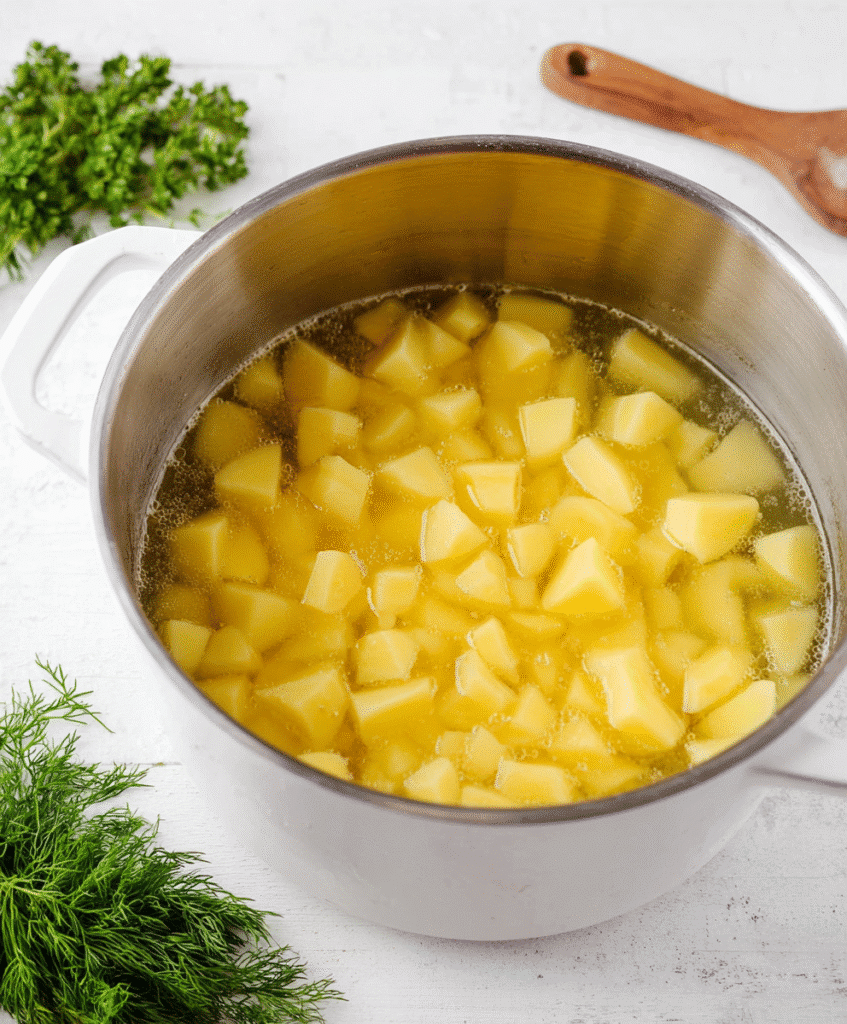
2. Boil with Salt
Add potatoes to a large pot with 1 tablespoon of salt and enough water to cover. Bring to a boil, then reduce to a simmer and cook for 10–12 minutes, or until fork-tender but not mushy.
3. Drain and Cool
Drain the potatoes and let them cool in a colander. Do not rinse—just allow them to dry naturally to avoid excess moisture in the salad.
4. Mix the Dressing
In a medium bowl, whisk together:
- 1 cup mayo
- ½ cup relish
- 2 tbsp mustard
- 2 tsp vinegar
- 1 tbsp sugar
- 1 tsp salt
- ½ tsp black pepper
- 1 tbsp chopped fresh dill
The dressing should be smooth, tangy, and slightly sweet—classic flavors in a Southern-style gluten-free potato salad.
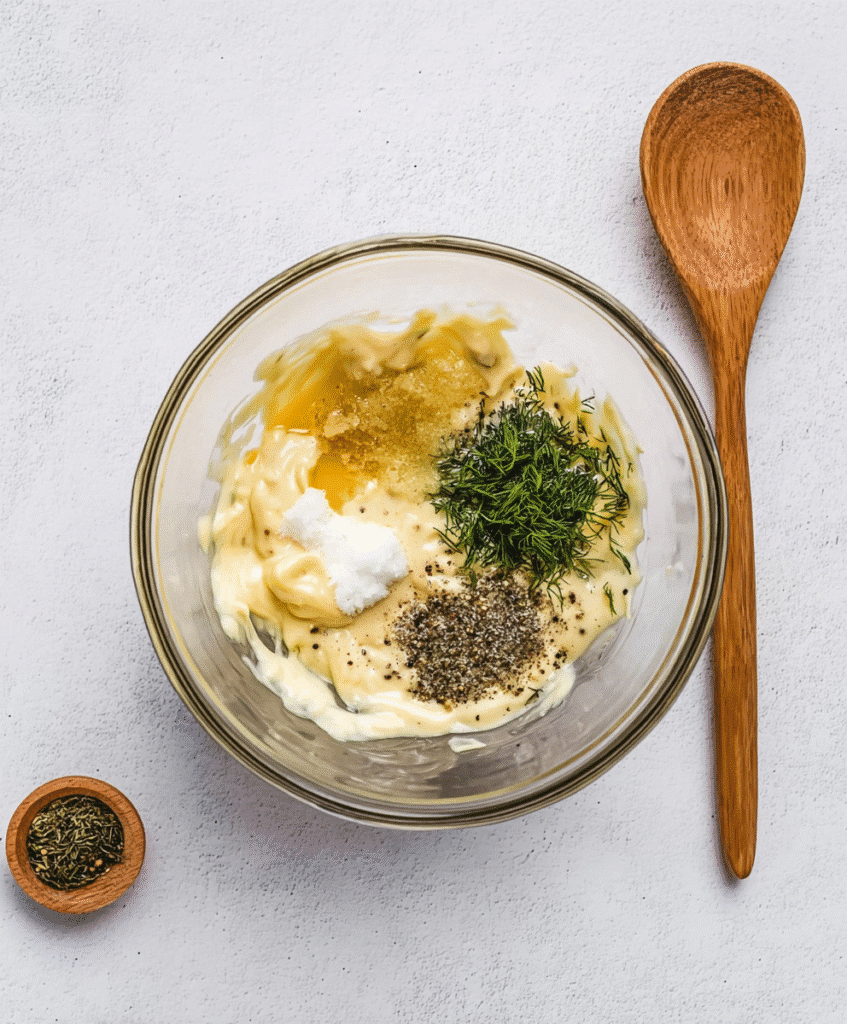
5. Combine Ingredients
In a large bowl, gently toss the cooled potatoes, diced celery, and onion. Add the dressing and fold until the potatoes are well coated.
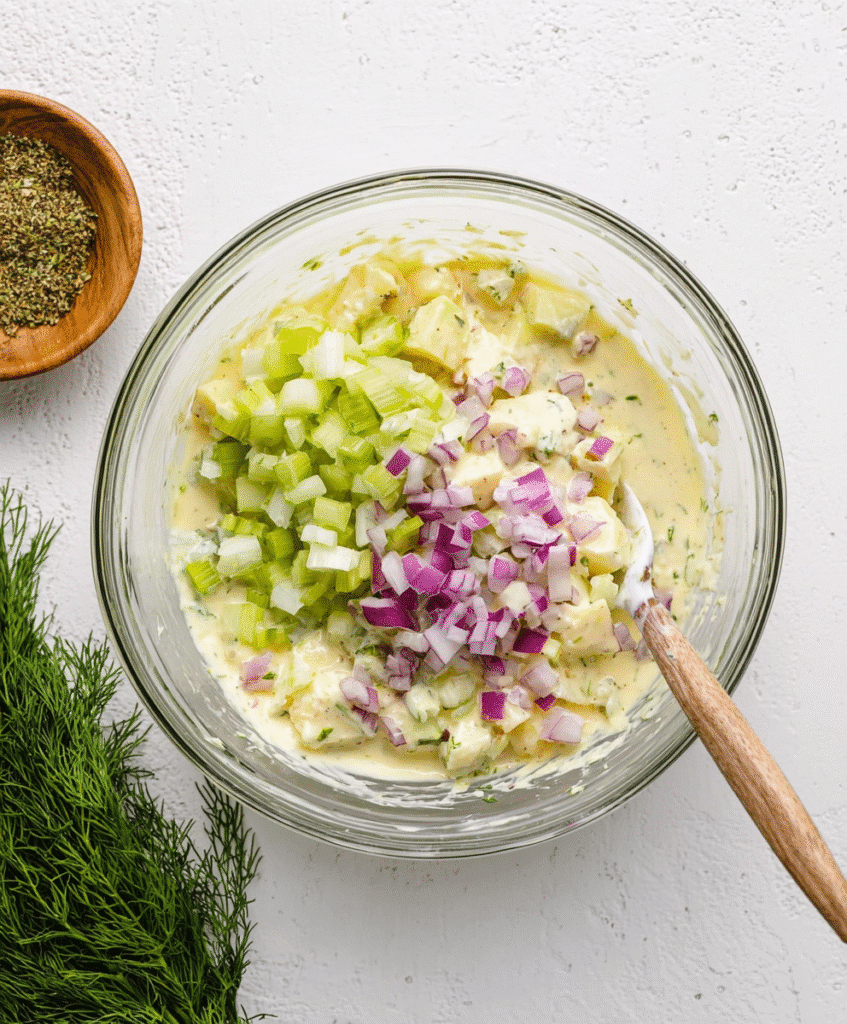
6. Add the Eggs
Carefully fold in the chopped boiled eggs. These add richness and protein, making the salad more filling.
7. Chill Before Serving
Cover and refrigerate the salad for at least 2 hours—overnight is even better. This lets the flavors meld and enhances the texture.
8. Garnish and Serve
Before serving, sprinkle paprika and extra dill on top. Serve chilled and enjoy!
This classic method ensures that your gluten-free potato salad is creamy, flavorful, and never soggy. It’s the kind of side dish people expect at family gatherings—and with these simple steps, you’ll make it better than ever.
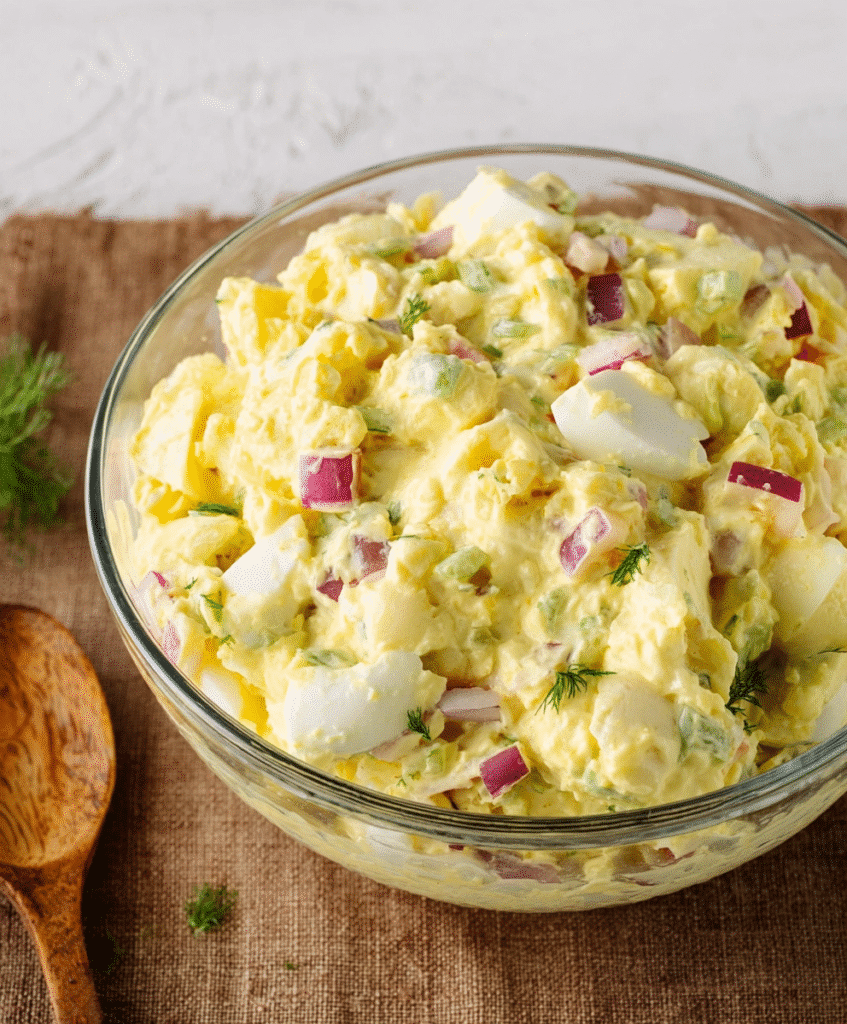
Don’t miss our crispy baked BBQ chicken thighs—the perfect main dish to pair with this creamy salad.
Ingredient Substitutions and Variations
Vegan, Dairy-Free, and Egg-Free Alternatives
One of the beautiful things about gluten-free potato salad is how versatile it can be. Whether you’re accommodating allergies or just prefer plant-based options, small swaps can make a huge difference—without sacrificing taste.
✅ Vegan Mayonnaise
Traditional mayo is made with eggs, but you can easily substitute it with:
- Vegan mayo brands like Just Mayo, Hellmann’s Vegan, or Follow Your Heart.
- Homemade vegan mayo made with aquafaba (chickpea water), oil, lemon juice, and mustard.
These options still offer that rich, creamy texture that makes gluten-free potato salad a crowd-pleaser.
✅ Egg Substitutes
Boiled eggs are a staple in Southern-style potato salad. But if you’re avoiding eggs entirely:
- Add chickpeas or white beans for protein and bulk.
- Use extra celery or diced cucumber for added texture.
- Try tofu cubes (lightly marinated) for a subtle, egg-like chew.
✅ Dairy-Free Adjustments
Most classic potato salad recipes are naturally dairy-free, but some versions include sour cream or milk-based dressings. Swap these for:
- Coconut yogurt (unsweetened) or cashew cream if a recipe calls for creamy dairy.
- Stick with vegan mayo and vinegar-based dressings for a safer route.
Healthier Ingredient Swaps Without Compromising Flavor
If you’re trying to keep things a little lighter—or just want a fresher twist on the classic—these substitutions still deliver flavor while reducing fat, sugar, or calories:
🥄 Lighten the Mayo
- Use half mayo, half plain Greek yogurt (for non-vegan version).
- For vegan or dairy-free, go half vegan mayo, half mashed avocado or hummus.
🍯 Sugar-Free Option
Southern-style gluten-free potato salad often includes a bit of sugar. If you’re watching your sugar intake:
- Skip the sugar entirely for a more savory blend.
- Add a splash of lemon juice or extra vinegar to brighten it up instead.
🌿 Boost Flavor Without Calories
- Add fresh herbs like parsley, chives, or green onions.
- Toss in capers, olives, or jalapeños for a punchy twist.
| Original Ingredient | Substitute Option | Benefits |
|---|---|---|
| Regular Mayo | Vegan or Light Mayo | Egg-free, plant-based |
| Boiled Eggs | Chickpeas or Tofu | Adds protein |
| Sugar | Omit or use lemon juice | Reduces sugar |
| Sweet Relish | Dill Relish + Apple | Brighter, less sweet |
| Mustard | Dijon or Whole Grain | Richer flavor |
These swaps allow you to personalize your gluten-free potato salad based on your guests, your goals, or just your mood that day. It’s comfort food that’s customizable, and that’s why it deserves a spot on your table—every season.
For a creamy complement, try our dairy-free ranch dressing as an egg-free potato salad topper.
Best Potatoes and Prep Tips for Texture and Taste
Why Yukon Gold Is the Best Potato Choice
When it comes to building the perfect gluten-free potato salad, your base ingredient matters—and not all potatoes are created equal. Yukon Gold potatoes are the top pick for one big reason: they strike the ideal balance between creamy and firm.
They’re considered a waxy potato, which means:
- They hold their shape after boiling.
- They offer a smooth, buttery texture.
- They absorb dressing without turning mushy.
In contrast, Russet potatoes, while starchy and fluffy, tend to fall apart when mixed with mayo or tossed with vinegar. Red potatoes are also waxy and work well—but they don’t have that same creamy bite you get from Yukons.
| Potato Type | Texture | Best For |
|---|---|---|
| Yukon Gold | Buttery & smooth | Creamy, rich potato salads |
| Red Potatoes | Firm & waxy | Chunkier salads with more bite |
| Russet Potatoes | Fluffy & dry | Baked potatoes, mashed |
Want a bonus tip? Leave some of the skin on Yukon Golds for extra texture, nutrients, and color contrast.
Boiling, Cooling, and Mixing Tips for Perfect Consistency
Here’s where many people go wrong with gluten-free potato salad: the cooking process. Undercook, and the potatoes are hard. Overcook, and they fall apart into a mayo mush. Here’s how to get it right every time.
✅ Start with Cold Water
Add your chopped potatoes to cold water before heating. This ensures they cook evenly all the way through.
✅ Salt the Water Generously
Think of it like pasta. Adding 1 tablespoon of salt to the boiling water infuses the potatoes with flavor from the start.
✅ Boil, Then Simmer
Bring to a boil, then lower the heat and simmer for 10–12 minutes, testing with a fork. They should be tender but not breaking apart.
✅ Don’t Rinse – Let Them Dry
After draining, don’t rinse your potatoes with cold water. That washes away the starch, which helps the dressing stick. Let them dry naturally for 5–10 minutes before mixing.
✅ Cool Slightly Before Mixing
Warm potatoes absorb the dressing beautifully, enhancing flavor throughout the dish. But too hot, and your mayo could split. Let them cool just a bit before dressing.
✅ Fold Gently
Use a soft spatula to fold ingredients instead of stirring aggressively. This keeps your potato pieces intact and prevents the salad from becoming gluey.
Perfecting the texture of your gluten-free potato salad is just as important as nailing the flavor. It’s this attention to detail—choosing the right spud, boiling with care, and mixing with love—that makes your salad go from “just okay” to “everyone-asks-for-seconds” good.
How to Serve Gluten-Free Potato Salad at Gatherings
Pairing Suggestions for BBQs, Picnics, and Potlucks
Nothing says summer like a heaping bowl of gluten-free potato salad on the table, surrounded by smoky BBQ meats and iced drinks. But this side dish isn’t just a filler—it’s a flavor anchor. Its creamy, tangy base brings balance to grilled, spiced, and even fried dishes.
Here’s how to pair your gluten-free potato salad for maximum crowd-pleasing effect:
| Main Dish | Why It Works |
|---|---|
| BBQ ribs or grilled chicken | Rich meats love the creamy contrast |
| Burgers (beef or veggie) | The salad adds a cool, tangy sidekick |
| Fried chicken | It echoes classic Southern picnic flavors |
| Hot dogs or brats | Easy to plate and balances the saltiness |
| Pulled pork or brisket | Offers freshness between smoky bites |
You can also pair it with:
- Grilled vegetables for a plant-based spread
- Corn on the cob and watermelon slices for that “July 4th” feel
- Gluten-free sandwich sliders or wraps for a modern twist
Make-Ahead Tips and Chilling for Maximum Flavor
Great news: gluten-free potato salad is a dream for meal prep. In fact, it gets better with time. The key is giving those flavors a chance to settle and mingle.
Here’s how to prep it like a pro:
✅ Make it the Day Before (if You Can)
Letting your salad chill overnight enhances every bite. The mayo absorbs into the potatoes, the seasoning distributes evenly, and the texture sets.
✅ Chill for at Least 2 Hours
If you don’t have a full night, give it a solid 2-hour fridge session. Warm salad can taste oily and unfinished.
✅ Stir Gently Before Serving
Give it a light stir before serving. If it feels dry after refrigeration, add a spoonful of mayo or a splash of vinegar to refresh it.
✅ Keep it Cool Outdoors
At picnics or BBQs, serve your gluten-free potato salad in a bowl over ice. This keeps it safe and tasting fresh longer.
✅ Presentation Matters
Garnish with a sprinkle of paprika, a few sprigs of dill, or even sliced eggs on top. It makes your salad feel special—because it is.
This dish isn’t just for your own plate—it’s a sharing food. By planning ahead and serving it with care, your gluten-free potato salad becomes more than a recipe—it becomes a memory at every table.
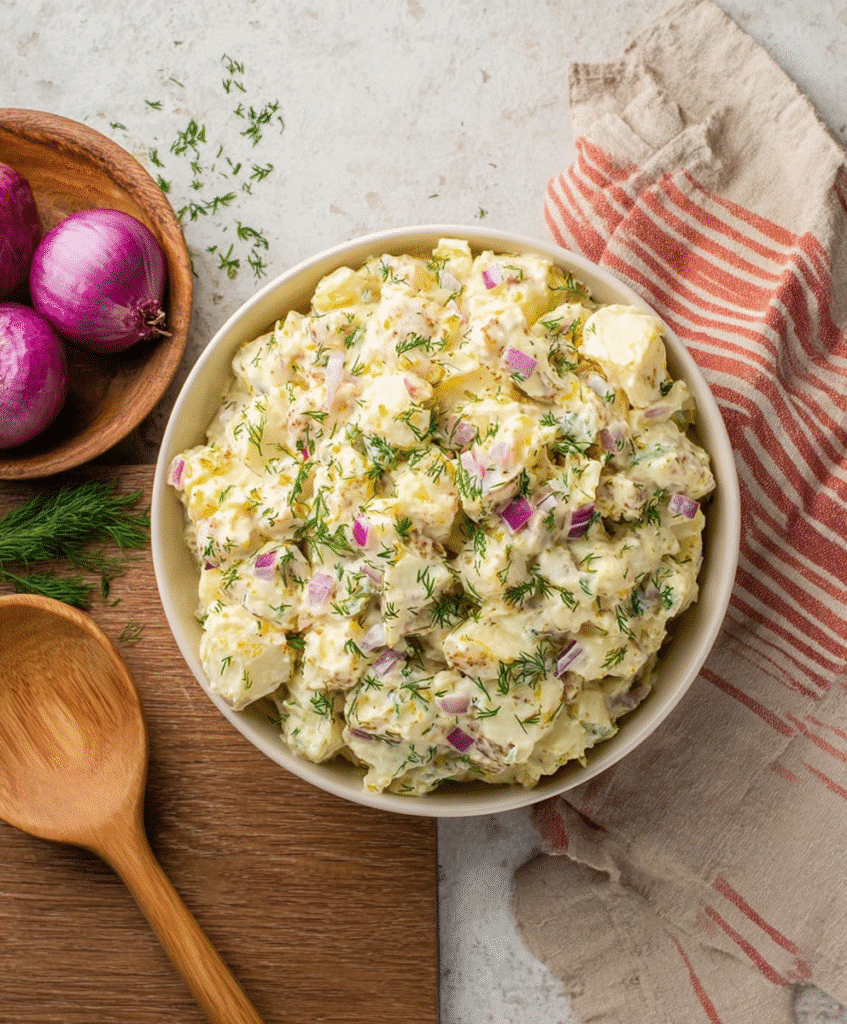
Check out these easy 4-ingredient gluten-free biscuits as a make-ahead option for your spread.”
Storing, Reheating, and Freshness Hacks
How Long Gluten-Free Potato Salad Lasts in the Fridge
Once your creamy gluten-free potato salad is made, storing it correctly is key. While it tastes best chilled for a few hours before serving, you’ll want to know how long it’ll stay fresh without losing its texture—or worse, turning unsafe to eat.
Here are the guidelines:
- Refrigerator Shelf Life: Up to 4 days when stored in an airtight container.
- Do NOT leave out for more than 2 hours (especially outdoors in summer heat).
- No freezing: Mayo-based dressings and boiled potatoes don’t freeze well. The texture breaks down and turns grainy once thawed.
| Storage Method | Shelf Life | Notes |
|---|---|---|
| Airtight container in fridge | 3–4 days | Keeps it fresh and creamy |
| Covered bowl in fridge | 1–2 days | May dry out more quickly |
| Freezer | Not recommended | Texture will suffer |
If you’re prepping for an event or batch cooking, make it 24 hours in advance and keep it sealed and cold. This timing gives the dressing a chance to absorb but stays well within the freshness window.
Tips to Keep It Creamy and Delicious After Chilling
Have you ever pulled out leftover gluten-free potato salad and found it dry or clumpy? That’s common—but totally fixable. Here are a few tricks to bring it back to life:
✅ Add a Splash of Moisture
If your salad has dried out in the fridge, stir in:
- A spoonful of gluten-free mayonnaise
- A dash of apple cider vinegar or lemon juice
- A little olive oil to reintroduce smoothness
Stir gently and taste-test before adding too much.
✅ Stir from the Bottom
Moisture often settles, so gently fold from the bottom to re-distribute dressing evenly.
✅ Serve Cold or Room Temp (Not Warmed)
Gluten-free potato salad should never be microwaved. Heating it breaks down the mayo, giving it an oily texture. If you must soften the chill, let it sit at room temperature for 10–15 minutes before serving.
✅ Label and Rotate
If you’re meal-prepping for multiple days, label your containers with the date and use the oldest one first. This helps you avoid waste and keeps things tasting fresh.
A properly stored gluten-free potato salad holds up wonderfully for a few days. With just a little prep and attention to freshness, you can enjoy this dish multiple times—whether it’s round two at dinner or lunch on a hot afternoon.
Common Mistakes When Making Gluten-Free Potato Salad
Hidden Gluten Sources to Avoid
When you’re committed to making a gluten-free potato salad, it’s easy to overlook a few ingredient labels—especially when you’re rushing or using pantry staples. But these tiny mistakes can have big consequences for someone with celiac disease or gluten sensitivity.
Here are the top sneaky gluten traps:
- Mustard and Relish: Some brands use wheat-based thickeners or malt vinegar. Always check for a certified gluten-free label.
- Vinegar: Malt vinegar is a red flag. Stick to apple cider vinegar or distilled white vinegar labeled gluten-free.
- Pre-mixed Seasoning Blends: Spice blends often contain wheat as a filler or anti-caking agent. Use single-ingredient spices like black pepper or paprika.
- Mayonnaise: While most major brands are gluten-free, some off-brands use additives that contain gluten. Play it safe with labeled brands.
Pro Tip: If it’s not labeled gluten-free and doesn’t come from a single whole food (like potatoes or eggs), double-check it.
Overmixing and Texture Pitfalls You Shouldn’t Ignore
You nailed the flavor, got the gluten-free part right… but then your salad turns out mushy, watery, or dry. Here’s why that happens—and how to fix it.
❌ Overcooking the Potatoes
Boil just until fork-tender. Overcooked potatoes fall apart during mixing, creating a starchy, gluey salad.
❌ Rinsing Potatoes After Boiling
This washes off the surface starch that helps the dressing cling to each bite. Let potatoes air dry instead.
❌ Adding Dressing to Hot Potatoes
If potatoes are too hot, mayo can split and become greasy. Let them cool slightly—still warm, but not steaming.
❌ Mixing Too Hard
Using a spoon to stir can break up the potatoes. Use a rubber spatula and gently fold the ingredients together.
| Mistake | Problem It Causes | Solution |
|---|---|---|
| Overcooked potatoes | Mushy texture | Boil 10–12 min max |
| Rinsing after boiling | Watery salad | Drain and let dry |
| Overmixing | Broken pieces, gluey salad | Fold gently with spatula |
| Hot dressing or potatoes | Split mayo | Let them cool slightly |
By watching for these common issues, you’ll create a gluten-free potato salad that’s as smooth, fresh, and flavorful as it should be—without any surprise texture disasters or gluten risks.
Is Store-Bought Potato Salad Really Gluten-Free?
What Labels to Look For in Packaged Salads
Here’s the truth: while many potato salads appear safe, not all store-bought potato salads are gluten-free. Just because potatoes, mayo, and mustard are gluten-free by nature doesn’t mean the final product is, especially when made commercially.
To ensure your store-bought potato salad is truly gluten-free, look for these cues on the label:
- “Certified Gluten-Free” seal: This is your safest bet.
- Allergen Statements: Look for “Contains: Wheat” under the ingredients panel. If it’s listed—put it back.
- Avoid malt vinegar: This is a common gluten ingredient in store brands.
- Check for modified food starch: It may contain gluten unless clearly labeled otherwise.
- Short ingredient lists: The simpler, the better. Fewer ingredients = fewer gluten risks.
Top Gluten-Free Certified Potato Salad Brands
If you’re short on time or hosting a last-minute BBQ, pre-made gluten-free potato salad can be a lifesaver—if you choose the right one. Here are a few trustworthy brands that offer certified gluten-free or widely accepted safe options:
| Brand | Product Line | Gluten-Free Status |
|---|---|---|
| Reser’s Fine Foods | Deviled Egg Potato Salad | Labeled GF on some lines |
| Trader Joe’s | Old-Fashioned Potato Salad | Not labeled GF, but no gluten ingredients |
| Whole Foods 365 | Potato Salad (Deli Section) | Varies by location—check with staff |
| Good & Gather (Target) | Original Potato Salad | Ingredients often GF, verify label |
| Freshness Guaranteed (Walmart) | Amish Potato Salad | Often GF, but not certified—check carefully |
Keep in mind: deli-prepared salads at grocery stores may come from shared prep surfaces, leading to cross-contamination. Always ask the deli manager if gluten is present in the prep area.
Bonus Tip: Make It “Store-Bought Easy” at Home
Want the convenience of store-bought without the gluten gamble? Prep a batch of gluten-free potato salad on Sunday using our easy recipe (see Part 2), and portion it out into meal prep containers. That way, you get homemade taste with store-bought simplicity all week long.
Bottom line? Store-bought can work—but it comes with risks. When in doubt, homemade gluten-free potato salad wins for both flavor and peace of mind.
Tips, Tricks & Best Practices for Long-Term Gluten-Free Potato Salad Success
Staying Ahead with Ingredient Swaps & Seasonal Twists
Let’s face it—no one wants the exact same gluten-free potato salad at every gathering. The key to longevity is creativity. By learning to mix and match ingredients based on the season or dietary needs, you turn one dish into many.
Here are a few fun variations to try:
| Season | Add-Ins or Swaps |
|---|---|
| Spring | Fresh peas, green onions, lemon zest |
| Summer | Roasted corn, chopped pickles, smoked paprika |
| Fall | Roasted sweet potatoes, grainy mustard, sage |
| Winter | Capers, kalamata olives, rosemary |
Want a fancier version? Try chopped bacon, Dijon mustard, and a drizzle of truffle oil. Hosting vegan guests? Stick with egg-free, dairy-free versions from Part 3 and go all-in with herbs and texture.
Avoiding the Most Common Pitfalls Over Time
Even pros slip up. But mastering gluten-free potato salad means staying sharp on the small stuff:
- Never assume “natural” means gluten-free. Always check condiments.
- Don’t make it too far ahead. Beyond 4 days, it loses texture fast.
- Resist the urge to overload with extras. Pick one “twist” per batch.
- Keep backups: Have extra mayo or mustard on hand for flavor refreshes.
Making It Your Signature Dish
With so many variations and serving styles, this can be your thing. Add a twist—like chopped dill pickles, roasted garlic, or smoked paprika—and make it recognizable at every party. When people say, “Did you bring the potato salad?”—you’ll know you nailed it.
Also, save a copy of your favorite combo in your phone or notebook. That way, if you’re shopping last minute, you’re ready to go without second-guessing ingredients.
Discover great ideas like our gluten-free pancake recipe for brunches that need more than just eggs and salad.
Conclusion
Gluten-free potato salad is more than just a side dish—it’s a Southern classic, a comfort food, and a memory-maker that just happens to be safe for everyone at your table. Whether you’re making it for a family BBQ or prepping lunches for the week, it’s one of those rare recipes that’s as practical as it is nostalgic.
By following clean ingredient practices, avoiding common mistakes, and trying out seasonal swaps, you can turn this dish into your signature staple—no gluten, no guesswork, just delicious comfort in every bite.
Follow us on Facebook & Pinterest for more gluten-free dessert ideas and community fun!
FAQ Section
Can you eat potato salad on a gluten-free diet?
Yes! Most homemade versions of potato salad are naturally gluten-free if you use whole ingredients and avoid hidden gluten in condiments like mustard or relish. Always check labels if you’re not sure.
Is store-bought potato salad gluten-free?
Not always. Some brands use malt vinegar, wheat-based thickeners, or cross-contaminate during prep. Look for certified gluten-free labels and short ingredient lists.
What is a gluten-free substitute for potato chips?
Great gluten-free alternatives include veggie chips, gluten-free tortilla chips, rice crackers, roasted chickpeas, or even seaweed snacks.
Is grandma’s potato salad gluten-free?
It depends. If she used simple, whole ingredients like potatoes, eggs, and mayo—it likely is. But always double-check any condiments or seasoning packets.
